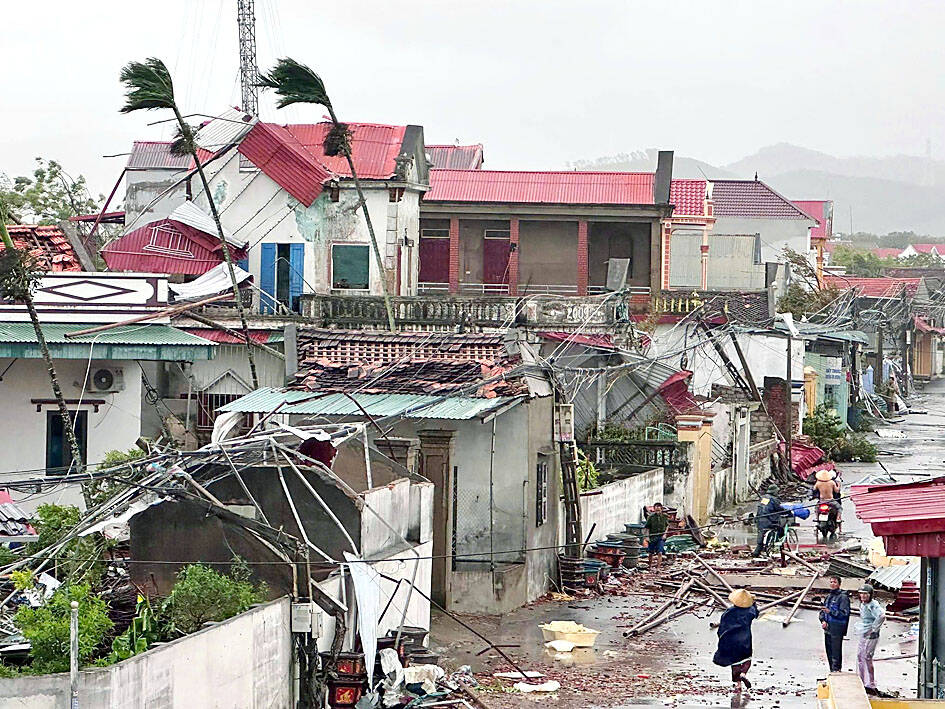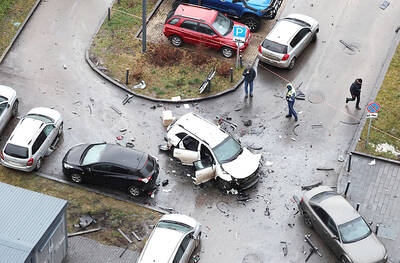A typhoon that ripped roofs off homes has killed dozens of people across Vietnam and the Philippines, officials from both nations said yesterday, as a weakened Bualoi crossed into neighboring Laos.
The typhoon battered small islands in the center of the Philippines last week, toppling trees and power pylons, unleashing floods and forcing 400,000 people to evacuate.
A Philippine civil defense official yesterday said that the death toll there had more than doubled to 24, with most of the victims either drowned or hit by debris.

Photo: Viet Hoang / VNExpress via AP
Scientists warn that storms are becoming more powerful as the world warms due to the effects of human-driven climate change.
In Vietnam, Bualoi made landfall as a typhoon late on Sunday, generating winds of 130kph.
Thousands of houses and businesses were damaged or destroyed in the nation’s center and north, and at least 11 people were killed, Vietnamese authorities said yesterday.
Images showed corrugated metal roofs blown off buildings and household debris strewn across inundated streets in Vietnam’s coastal Nghe An Province.
“The wind blew my roof to the sky and then it fell down, breaking everything. I had to cover my head and rushed to my neighbor’s house to be safe,” Trinh Thi Le, 71, in central Quang Tri Province, was quoted as saying by the state-run Tuoi Tre newspaper.
At least nine people were killed when a typhoon-related whirlwind swept through northern Ninh Binh Province early yesterday, according to the local disaster agency.
One person was killed in the province of Hue and another in Thanh Hoa, while about 20 were missing, local and national disaster authorities reported.
Among those unaccounted for were nine people whose fishing boats were lost at sea on Sunday night after their vessels came loose from their moorings during strong winds and currents, police said.
More than 53,000 people were evacuated to schools and medical centers converted into temporary shelters ahead of Bualoi hitting Vietnam, the Vietnamese Ministry of Agriculture and Environment said.
Four domestic airports and part of the national highway were closed yesterday. More than 180 flights had been canceled or delayed, airport authorities said.
Parts of Nghe An and the steel-producing central province of Ha Tinh were without power and schools were closed in affected regions.
Since making landfall in Vietnam, Bualoi has weakened as it moved across the border into Laos.
It came on the heels of Super Typhoon Ragasa, which killed 14 people across the northern Philippines.
In Vietnam, 175 people were killed or went missing due to natural disasters from January to August, the General Statistics Office said.
Total damages were about US$371 million, almost triple the amount of the same period last year, the office said.

A car bomb killed a senior Russian general in southern Moscow yesterday morning, the latest high-profile army figure to be blown up in a blast that came just hours after Russian and Ukrainian delegates held separate talks in Miami on a plan to end the war. Kyiv has not commented on the incident, but Russian investigators said they were probing whether the blast was “linked” to “Ukrainian special forces.” The attack was similar to other assassinations of generals and pro-war figures that have either been claimed, or are widely believed to have been orchestrated, by Ukraine. Russian Lieutenant General Fanil Sarvarov, 56, head

SAFETY FIRST: Double the number of police were deployed at the Taipei Marathon, while other cities released plans to bolster public event safety Authorities across Taiwan have stepped up security measures ahead of Christmas and New Year events, following a knife and smoke bomb attack in Taipei on Friday that left four people dead and 11 injured. In a bid to prevent potential copycat incidents, police deployments have been expanded for large gatherings, transport hubs, and other crowded public spaces, according to official statements from police and city authorities. Taipei Mayor Chiang Wan-an (蔣萬安) said the city has “comprehensively raised security readiness” in crowded areas, increased police deployments with armed officers, and intensified patrols during weekends and nighttime hours. For large-scale events, security checkpoints and explosives

PUBLIC SAFETY: The premier said that security would be tightened in transport hubs, while President Lai commended the public for their bravery The government is to deploy more police, including rapid response units, in crowded public areas to ensure a swift response to any threats, President William Lai (賴清德) said yesterday after a knife attack killed three people and injured 11 in Taipei the previous day. Lai made the remarks following a briefing by the National Police Agency on the progress of the investigation, saying that the attack underscored the importance of cooperation in public security between the central and local governments. The attack unfolded in the early evening on Friday around Taipei Main Station’s M7 exit and later near the Taipei MRT’s Zhongshan

REBUFFED: In response to Chinese criticism over recent arms sales, Washington urged Beijing to engage in meaningful dialogue instead of threats and intimidation Washington’s long-term commitment to Taiwan would not change, the US Department of State said yesterday, urging Beijing to stop pressuring Taiwan and engage in meaningful bilateral dialogues. The remarks came in response to a backlash from Beijing about Washington’s latest approval of arms sales to Taiwan. The US Defense Security Cooperation Agency said in a statement on Wednesday that the Taipei Economic and Cultural Representative Office in the US has asked to purchase an arms package, including Tactical Mission Network Software; AH-1W helicopter spare and repair parts; M109A7 self-propelled howitzers; HIMARS long range precision strike systems; tube-launched, optically tracked, wire-guided missiles; Javelin